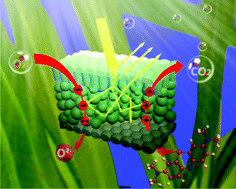Aquatic plant inspired hierarchical artificial leaves for highly efficient photocatalysis†
Abstract
The natural leaf provides a superior template for engineering the artificial leaf in order to perform light energy conversion. To adapt to the aquatic environments, the aquatic plant leaves usually are thin and soft with excellent mass transportation and light-harvesting capability. In this report, the aquatic leaf is directly employed as a template to construct bioinspired hierarchical photocatalyst while mesoporous directing agent act as a second template. The dual templates consequently ensure the obtained TiO2 with optimal light harvesting structure, high surface area and excellent mass transportation, which contribute to improve photocatalytic capability. Specially, SiO2 is also introduced to form TiO2–SiO2 composite in the final hierarchical replica in order to improve the stability of mesostructures, perfect replication of leaves' fine structures and the


 Please wait while we load your content...
Please wait while we load your content...